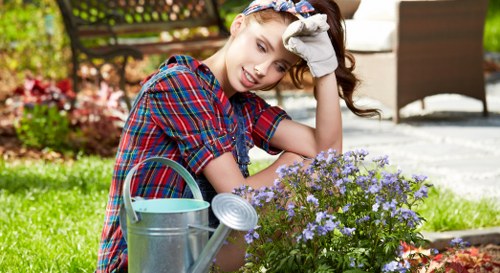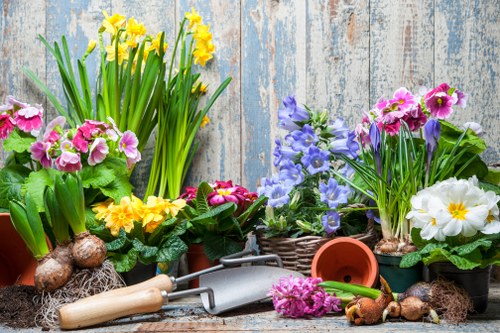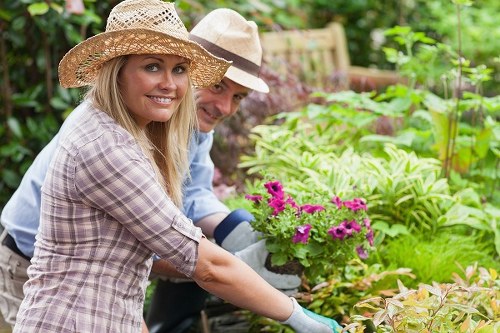Comprehensive Guide to Garden Maintenance in Bow

Maintaining a beautiful garden in Bow requires **consistent care** and attention to detail. Whether you're a seasoned gardener or a beginner, understanding the essential tasks involved in garden maintenance can help you achieve a lush and thriving outdoor space.
Garden maintenance involves a variety of activities, including pruning, weeding, watering, and fertilizing. Each of these tasks plays a crucial role in ensuring the health and vitality of your plants.
In Bow, the local climate and soil conditions can influence the specific maintenance practices you should adopt. Tailoring your garden care routine to the unique environment of Bow will yield the best results.

Essential Garden Maintenance Tasks
To keep your garden in Bow looking its best, focus on these key maintenance tasks:
- Pruning: Regular pruning helps maintain plant shape and promotes healthy growth.
- Weeding: Removing unwanted weeds prevents competition for nutrients and water.
- Watering: Consistent watering is vital, especially during dry spells.
- Fertilizing: Providing the right nutrients ensures robust plant development.
- Pest Control: Managing pests protects your plants from damage.
Each task requires specific techniques and tools to perform effectively.

Seasonal Garden Maintenance in Bow
Different seasons bring distinct challenges and opportunities for your garden. Understanding how to adjust your maintenance routine throughout the year is essential for sustained garden health.
Spring
Spring is the time to prepare your garden for the growing season. Begin by cleaning up any debris from the winter months and pruning back dead branches.
- Soil Preparation: Test and amend the soil to ensure it’s fertile.
- Planting: Introduce new plants and flowers to add variety.

Summer
During the summer, focus on regular watering and pest management. High temperatures can stress plants, so maintaining moisture levels is crucial.
- Mulching: Apply mulch to help retain soil moisture.
- Pest Monitoring: Keep an eye out for common garden pests and address issues promptly.
Consistent care during the summer months will help your garden flourish.

Autumn
Autumn is the perfect time to prepare your garden for the colder months. Start by harvesting any remaining produce and removing spent plants.
- Leaf Cleanup: Rake and compost fallen leaves to prevent mold growth.
- Plant Protection: Shield sensitive plants from frost and cold temperatures.
Proper autumn maintenance sets the stage for a healthy spring garden.
Choosing the Right Plants for Bow Gardens
Selecting plants that thrive in Bow’s climate is vital for successful garden maintenance. Opt for species that are well-suited to local conditions to minimize care requirements and maximize growth.
Consider factors such as sunlight exposure, soil type, and water availability when choosing plants for your garden.
- Native Plants: These are adapted to the local environment and require less maintenance.
- Drought-Tolerant Varieties: Ideal for areas with limited water resources.
- Seasonal Flowers: Provide color and interest throughout the year.
Tools and Equipment for Effective Garden Maintenance
Having the right tools can make garden maintenance tasks easier and more efficient. Invest in quality equipment to ensure optimal results.
- Pruners: Essential for trimming and shaping plants.
- Garden Fork: Useful for aerating soil and removing weeds.
- Watering Systems: Automated systems can help maintain consistent watering schedules.
- Fertilizers and Soil Amendments: Provide necessary nutrients for plant health.
Regularly maintaining your tools ensures they remain effective and safe to use.
DIY vs. Professional Garden Maintenance Services
Deciding between DIY garden maintenance and hiring professional services depends on several factors, including time, expertise, and budget.
DIY Garden Maintenance
If you have the time and enjoy gardening, maintaining your garden yourself can be rewarding and cost-effective. However, it requires knowledge and dedication to ensure your garden thrives.
- Cost Savings: Avoid labor costs associated with hiring professionals.
- Personal Satisfaction: Enjoy the hands-on process of gardening.
Professional Garden Maintenance Services
For those with busy schedules or limited gardening experience, professional services offer expertise and convenience. Professionals can provide tailored care plans to meet your garden’s specific needs.
- Expertise: Access to knowledge and skills for optimal garden health.
- Time Efficiency: Save time by outsourcing maintenance tasks.
Choosing the right approach depends on your individual preferences and circumstances.
Eco-Friendly Garden Maintenance Practices
Adopting eco-friendly practices not only benefits your garden but also the environment. Implementing sustainable methods can enhance soil health, conserve water, and reduce chemical usage.
Composting
Composting organic waste recycles nutrients back into the soil, improving its fertility and structure.
- Reduce Waste: Minimize household waste by composting plant debris.
- Soil Enrichment: Provide natural fertilizers for your plants.
Integrated Pest Management (IPM)
IPM focuses on using natural pest control methods to reduce reliance on chemicals.
- Biological Controls: Introduce beneficial insects to manage pest populations.
- Mechanical Controls: Use barriers and traps to prevent pest access.
Eco-friendly practices promote a sustainable and healthy garden ecosystem.
Common Challenges in Garden Maintenance and Solutions
Every gardener faces challenges that can impede garden health. Identifying and addressing these issues promptly is key to maintaining a thriving garden.
Pest Infestations
Pests can cause significant damage to plants. Implementing preventive measures and effective treatments is essential.
- Prevention: Maintain garden cleanliness to deter pests.
- Treatment: Use eco-friendly pesticides or natural remedies as needed.
Weed Control
Weeds compete with plants for resources. Regular weeding is necessary to keep your garden healthy.
- Manual Removal: Hand-pull weeds to prevent them from spreading.
- Mulching: Apply mulch to suppress weed growth.
Effective weed control ensures your plants receive adequate nutrients and water.
Enhancing Garden Aesthetics
Maintaining a visually appealing garden involves more than just plant care. Incorporate design elements and decorative features to enhance the overall look and feel of your outdoor space.
- Pathways: Create defined paths to guide visitors through your garden.
- Lighting: Use garden lighting to highlight key features and extend garden use into the evening.
- Water Features: Incorporate fountains or ponds to add a tranquil element.
Thoughtful design choices can transform your garden into a beautiful and inviting retreat.
Seasonal Planting Tips for Bow Gardens
Strategically planting your garden according to the seasons can optimize growth and bloom cycles. Plan your planting schedule to align with Bow’s climatic patterns.
Early Spring
Plant hardy vegetables and perennials that can withstand cooler temperatures.
- Vegetables: Peas, lettuce, and spinach.
- Flowers: Pansies, daffodils, and tulips.
Late Spring
Introduce heat-loving plants that thrive in the warmer months.
- Vegetables: Tomatoes, peppers, and cucumbers.
- Flowers: Marigolds, petunias, and zinnias.
Watering Strategies for a Healthy Garden
Proper watering is fundamental to garden maintenance. Implement effective watering strategies to ensure your plants receive adequate moisture without overwatering.
Timing Your Watering
The best time to water plants is early in the morning or late in the evening to minimize evaporation.
- Morning Watering: Promotes deep root growth and reduces the risk of fungal diseases.
- Evening Watering: Useful during very hot days to provide immediate relief.
Watering Techniques
Adopt techniques that target root areas and conserve water.
- Drip Irrigation: Delivers water directly to the base of plants, reducing waste.
- Soaker Hoses: Effective for large garden areas, ensuring even moisture distribution.
Efficient watering practices support plant health and save water resources.
Fertilizing Your Garden in Bow
Fertilizing provides essential nutrients that may be missing from the soil. Proper fertilization promotes plant growth and enhances bloom quality.
Types of Fertilizers
Choose fertilizers based on your garden's specific needs.
- Organic Fertilizers: Natural options like compost and manure enrich the soil without harmful chemicals.
- Synthetic Fertilizers: Provide targeted nutrients for specific plant requirements.
Application Tips
Apply fertilizers correctly to avoid overfeeding or nutrient imbalances.
- Read Labels: Follow the recommended application rates and instructions.
- Timing: Fertilize during active growth periods for maximum benefit.
Balanced fertilization supports robust and healthy plant development.
Pruning Techniques for a Thriving Garden
Pruning is essential for maintaining plant health, encouraging growth, and enhancing aesthetics. Proper techniques vary depending on the type of plant.
When to Prune
Understanding the appropriate timing for pruning ensures optimal results.
- Flowering Plants: Prune after blooming to shape the plant and promote future flowers.
- Trees and Shrubs: Early spring is ideal for structural pruning before new growth begins.
Pruning Methods
Utilize the correct methods to avoid damaging plants.
- Thinning: Remove entire branches to improve air circulation and light penetration.
- Heading: Cut back to a bud or lateral branch to encourage bushier growth.
Consistent pruning practices lead to healthier and more attractive plants.
Weed Control Strategies
Effective weed control is necessary to maintain garden health and appearance. Weeds compete with desired plants for resources, so managing them is crucial.
Preventive Measures
Implement strategies to minimize weed growth from the start.
- Mulching: Apply a thick layer of mulch to suppress weed seedlings.
- Landscape Fabric: Use barriers to prevent weed emergence in garden beds.
Removal Techniques
When weeds appear, remove them promptly to prevent spread.
- Hand Pulling: Remove weeds by hand, ensuring roots are fully extracted.
- Hoeing: Use a hoe to cut weeds below the soil surface.
Consistent weed management keeps your garden healthy and vibrant.
Implementing Sustainable Garden Practices
Sustainability in garden maintenance reduces environmental impact and promotes long-term garden health. Adopting eco-friendly practices can lead to a more resilient and productive garden.
Water Conservation
Conserving water ensures your garden remains thriving even during dry periods.
- Drought-Tolerant Plants: Choose species that require less water.
- Rainwater Harvesting: Collect and use rainwater for irrigation.
Soil Health
Maintaining healthy soil is fundamental to plant growth and sustainability.
- Crop Rotation: Rotate plant families to prevent soil depletion.
- Cover Crops: Grow cover crops to protect and enrich the soil.
Healthy, sustainable practices lead to a flourishing and eco-friendly garden.
Dealing with Seasonal Pests
Different seasons bring specific pest challenges. Understanding these patterns helps in effectively managing pest populations.
Spring Pests
Spring is a time when many pests become active. Common spring pests include:
- Aphids: Small insects that suck sap from plants.
- Slugs and Snails: Mollusks that feed on leaves and stems.
Summer and Autumn Pests
As temperatures rise, so does pest activity. Key pests during these seasons include:
- Caterpillars: Larvae that can defoliate plants.
- Beetles: Various species that can damage foliage and fruit.
Implementing targeted pest control measures ensures your garden remains pest-free throughout the year.
Maintaining Garden Tools
Proper maintenance of garden tools ensures longevity and efficiency. Well-maintained tools make garden maintenance tasks easier and safer.
- Cleaning: Remove dirt and debris after each use to prevent rust and damage.
- Sharpening: Keep blades sharp for effective cutting and pruning.
- Storage: Store tools in a dry, sheltered area to protect them from the elements.
Regularly maintaining your tools enhances their performance and extends their lifespan.
Creating a Garden Maintenance Schedule
Organizing your garden maintenance tasks into a schedule helps ensure consistency and thoroughness. A well-planned schedule keeps your garden in optimal condition all year round.
Monthly Tasks
- January: Plan your garden layout and order seeds.
- February: Prepare soil and start indoor seed germination.
- March: Begin planting early vegetables and flowers.
Seasonal Tasks
- Spring: Plant new species, prune trees, and apply mulch.
- Summer: Water regularly, control pests, and harvest produce.
- Autumn: Clean up garden beds, plant cover crops, and prepare for winter.
- Winter: Protect sensitive plants and plan for the next growing season.
Adhering to a maintenance schedule ensures all aspects of your garden receive the attention they need.
Benefits of Regular Garden Maintenance
Consistent garden maintenance offers numerous benefits, enhancing both the aesthetics and functionality of your outdoor space.
- Healthier Plants: Regular care prevents diseases and promotes robust growth.
- Enhanced Curb Appeal: A well-maintained garden adds beauty to your property.
- Increased Property Value: Attractive gardens can boost the value of your home.
- Personal Well-Being: Gardening can reduce stress and provide a sense of accomplishment.
Investing time and effort into garden maintenance yields both tangible and intangible rewards.
Conclusion
Effective garden maintenance in Bow involves a combination of regular care, strategic planning, and sustainable practices. By understanding the unique challenges and opportunities presented by Bow’s climate and environment, you can cultivate a thriving and beautiful garden.
Whether you choose to maintain your garden yourself or enlist the help of professional services, consistent attention to maintenance tasks will ensure your garden remains a vibrant and enjoyable space.
Contact us today to learn more about professional garden maintenance services in Bow and take the first step towards creating your dream garden.
Book your service now and enjoy a lush, well-maintained garden all year round!